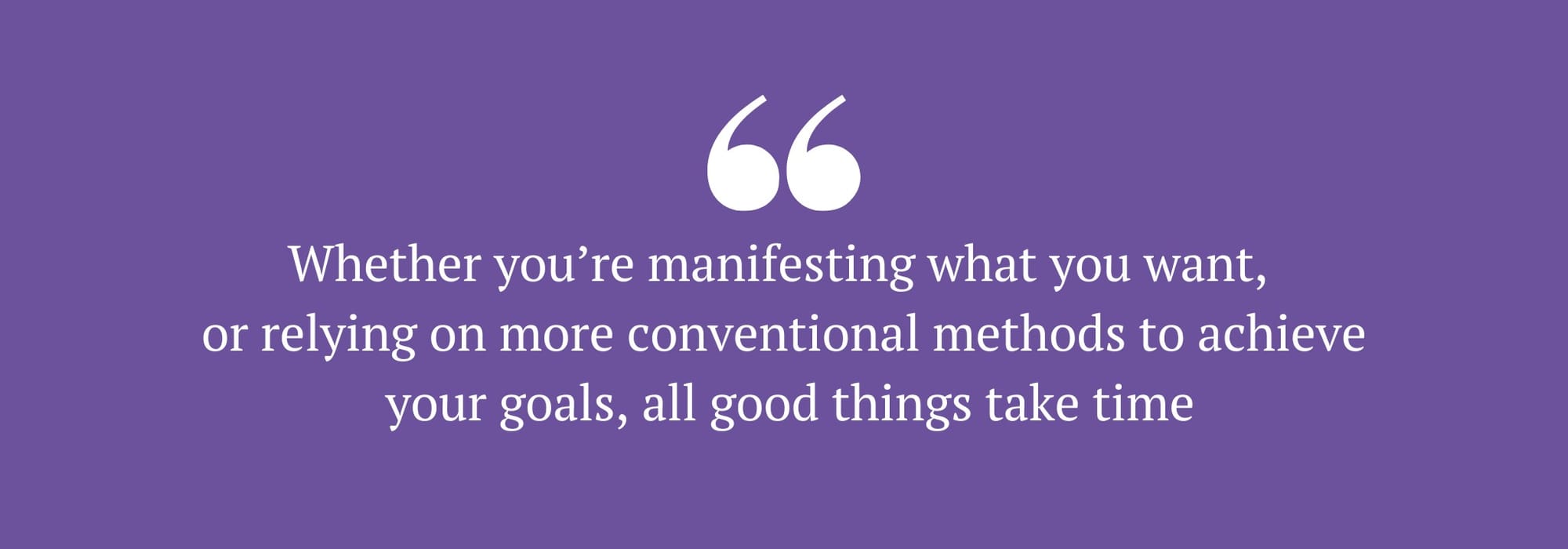Investigating the dark side of new age philosophy by asking: what’s manifestation doing to mental health?
At one point or another, you’ve probably heard the phrase “Shoot for the moon. Even if you miss, you’ll land among the stars.” Perhaps you spotted this quote from Norman Vincent Peale in a personal development book, or on your favourite self-help guru’s Instagram page.
With the rise of manifestation trends, and the enduring popularity of new age philosophy, we’re seeing messages like these more and more. Manifestation posits that if we only dream big enough, and think positively enough, we can have, do, and be everything we’ve ever wanted.
By controlling our thoughts, we can control the world around us, and overcome obstacles that have held us back in the past. It’s an alluring idea, but what’s it doing to our mental health?
When we set the bar for achievement so high, disregarding our unique struggles and challenges, not to mention the often harsh realities of the world around us, are we simply setting ourselves up for feelings of disappointment and failure?
Sure, it can feel good to be positive, but what happens when wishful thinking doesn’t work?
Too much, too soon
Marilyn Devonish, a coach and multi-disciplinary therapist, believes manifestation – the process of thinking and feeling your goals into existence – can be incredibly empowering.
“On the whole, the manifestation trend can be amazing, and when handled well, it’s often fun, exciting, and empowering. It gives you something to look forward to, and expands the mind and our perception of possibility.”
However, Marilyn explains that problems can arise when we expect instant gratification. When we set an intention so far removed from our current reality and expect it to manifest straight away, but instead see little change in our reality, it can be a recipe for stress, and self-doubt.
What’s more, it can perpetuate a cycle of tirelessly striving for more, while constantly being less than content with what you already have.
Marilyn compares it to taking a glass from hot to cold. “Imagine you take a glass out of the freezer and put it straight on a hot stove. The contrast is just too great, and it will shatter,” she says. “In terms of your mental health, this can set up a cycle of feeling disappointed and frustrated. It can be demoralising and even cause doubts about our core identity, like believing you’re not good enough, or capable enough, to be, do, or have what you want.”
While setting grand goals can be inspiring for some, it can be overwhelming for others, and setting the bar too high may put you under unnecessary pressure.
While dreaming big may help you push past your limits and realise what you’re capable of, research suggests our mental health may fare better when we aim for more manageable targets – at least while starting out.
Just ask Frank L Smoll, a psychologist at the University of Washington, whose research on goal-setting led him to the conclusion that the most effective goals are those that are achievable and believable.
Or consider ‘thought-action fusion’, a psychological term that – similarly to manifestation – refers to the belief that thoughts and actions are linked. Research by Johanna Thompson-Hollands et al, in the Journal of Nervous and Mental Disease, shows that ‘thought-action fusion’ is actually a risk factor for anxiety, depression, and OCD.

Can positivity be toxic?
Have you ever tried to make it through an entire day without complaining, or squashed down negative feelings when you’re feeling sad? Toxic positivity doesn’t feel good and it isn’t healthy, and yet with an insistence on emitting ‘good vibes only’, manifestation may encourage you to ignore mental health red flags.
You might push away that anxious feeling in the pit of your stomach instead of investigating it, or tell friends you’re on top of the world when you’re feeling anything but. Marilyn Devonish says avoiding or denying your emotions in this way is dangerous ground.
“If you only focus on the positive, you can start to feel weak or like a failure for feeling anything less than good, happy, and positive, and the irony is, the very emotions you are attempting to avoid can become heightened, and even more ferocious in their intensity,” she surmises.
“It’s better to explore and deal with these emotions so you can move on, otherwise it’s like a Jack-in-the-box just waiting to be triggered,” she points out.
Still, many people around the world say that manifestation has helped them to achieve things that they once thought were beyond the realm of possibility. It’s allowed them to see themselves and their abilities in a whole different light, and, in many cases, lead happier, more well-rounded, and abundant lives as a result.
Minding your mental health while manifesting
So if, like so many others, you want to use manifestation techniques to achieve anything from a better salary and a promotion to a thriving social life, and a new group of friends, how can you do it while minding your mental health?
If you have a lengthy list of goals and you’re feeling overwhelmed, Lois Goodman, a holistic coach specialising in mindset and transformation, recommends the staircase technique.
“It works by drawing a staircase on a piece of paper,” she explains. “You write your goal at the top, and then one step at a time, working from the bottom, you reverse engineer the process of achieving that goal. This means deciding what first steps you need to take to make your dreams a reality.”
The good news? You don’t need to have it all figured out: you just need to suss out those all-important first steps.
Shadow work, the process of acknowledging and working through your darker thoughts, is also a key part of your journey. “Shadow practices like journaling and inner child healing allow you to be aware, acknowledge, and feel the emotions that are challenging, before releasing them and moving forward,” Lois says. “If you skip this crucial step, you will hinder yourself and find it’s more difficult to move forward and implement lasting change.”
It’s important to be aware that shadow work can trigger deeply held memories and emotions, so if you feel this is a risk for you, consider exploring this under the guidance of a psychotherapist, who is trained in shadow methods.
Remember: human emotions exist on a spectrum, and we aren’t built to feel happy and positive all the time. In fact, research from the University of California, Berkeley, published in Proceedings of the National Academy of Sciences, suggests that humans experience at least 27 different emotions, and it’s normal to travel through everything from horror and sadness, to awe and peace, many times a day. So take that as permission to feel all your feelings, no matter how far removed they seem from the culture of constant positivity.
Ultimately, Lois says, you need to “embrace the darkness you have inside you, and let it ride through you, to allow the light to break through”.
A healthy dose of perspective and plenty of patience when manifesting can work wonders as well. After all, whether you’re manifesting what you want, or relying on more conventional methods to achieve your goals, all good things take time.


Comments